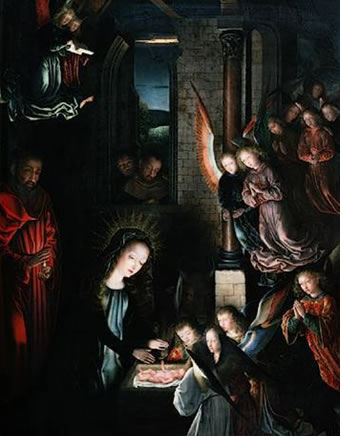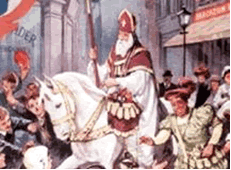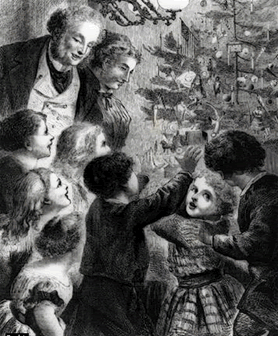
Christmas is the annual Christian holiday commemorating the birth of Jesus Christ . Most members of the Roman Catholic Church and followers of Protestantism celebrate Christmas on December 25, and many celebrate on the evening of December 24 as well. Members of the Eastern Orthodox Church usually delay their most important seasonal ceremonies until January 6, when they celebrate Epiphany , a commemoration of the baptism of Jesus. Epiphany also traditionally commemorates the arrival of the Three Wise Men of the East in Bethlehem (near Jerusalem , Israel ), where they adored the infant Jesus and myrrh. The official Christmas season, popularly known as either Christmastide or the Twelve Days of
Christmas, extends from the anniversary of Christ's birth on December 25 to the feast of Epiphany on January 6.
RISE OF THE MODERN AMERICAN CHRISTMAS
In the United States and Canada , many elements of modern Christmas celebrations did not emerge until the 19th century. Before then Christmas had been an ordinary workday in many communities, particularly in New England , where early Puritan objections to Christmas celebrations remained highly influential. Among some groups, Christmas was an especially boisterous event, characterized by huge feasts, drunkenness, and raucous public revelry. In an English tradition that survived in some parts of North America, Christmas revelers would dress in costume and progress from door to door to receive gifts of food and drink. Most holiday gifts were limited to small amounts of money and modest presents passed from the wealthy to the poor and from masters to their servants. Families almost never exchanged Christmas gifts among themselves.
SANTA CLAUS
As Christmas evolved in the United States , new customs were adopted and many old ones were reworked. The legend of Santa Claus, for example, had origins in Europe and was brought by Dutch settlers to New York in the early 18th century.  Traditionally, Santa Claus—from the Dutch Sinter Klaas—was depicted as a tall, dignified, religious figure riding a white horse through the air. Known as Saint Nicholas in Germany , he was usually accompanied by Black Peter, an elf who punished disobedient children. In North America he eventually developed into a fat, jolly old gentleman who had neither the religious attributes of Saint Nicholas nor the strict disciplinarian character of Black Peter.
Traditionally, Santa Claus—from the Dutch Sinter Klaas—was depicted as a tall, dignified, religious figure riding a white horse through the air. Known as Saint Nicholas in Germany , he was usually accompanied by Black Peter, an elf who punished disobedient children. In North America he eventually developed into a fat, jolly old gentleman who had neither the religious attributes of Saint Nicholas nor the strict disciplinarian character of Black Peter.
THE CHRISTMAS TREE
While Santa Claus became increasingly familiar to Americans, the German Christmas tree also acquired popularity in North America . As early as the 17th century, Germans had transformed this pagan symbol of fertility into a Christian symbol of rebirth. According to legend, the Christmas  tree tradition began with the founder of German Protestantism, Martin Luther. While walking through the forest on Christmas Eve, Luther was so moved by the beauty of the starlit fir trees that he brought one indoors and decorated it with candles to remind his children of God's creation. In 1841 Prince Albert of Germany gave his wife, Queen Victoria of England , a gift of a Christmas tree. This was reputedly the first Christmas tree in England , but the custom spread quickly. German immigrants took the Christmas tree to other parts of Europe and to the United States and Canada , where it soon became a popular tradition. Blown-glass ornaments, tin angels, paper chains, candles, cornucopias filled with sugarplums, and other decorations made the simple evergreen tree into a beautiful parlor centerpiece at Christmastime.
tree tradition began with the founder of German Protestantism, Martin Luther. While walking through the forest on Christmas Eve, Luther was so moved by the beauty of the starlit fir trees that he brought one indoors and decorated it with candles to remind his children of God's creation. In 1841 Prince Albert of Germany gave his wife, Queen Victoria of England , a gift of a Christmas tree. This was reputedly the first Christmas tree in England , but the custom spread quickly. German immigrants took the Christmas tree to other parts of Europe and to the United States and Canada , where it soon became a popular tradition. Blown-glass ornaments, tin angels, paper chains, candles, cornucopias filled with sugarplums, and other decorations made the simple evergreen tree into a beautiful parlor centerpiece at Christmastime.
Microsoft ? Encarta ? Reference Library 2005. ? 1993-2004 Microsoft Corporation.